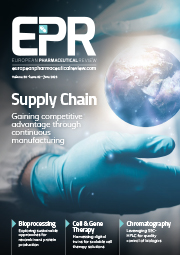Elemental impurities testing and specification limits – ICH Q3D
Posted: 22 December 2018 | Dave Elder (JPAG Member and David P Elder Consultancy) | 3 comments
The introduction of ICH Q3D (Guideline for Elemental Impurities)1 was an additional safety-based guidance for toxic impurities that complemented the existing ICH Q3C(R5) (Impurities: Guideline for residual solvents)2 and ICH M7(R1) (Assessment and control of DNA reactive (mutagenic) impurities in pharmaceuticals to limit potential carcinogenic risk);3 as well as the existing guidelines for non-toxic impurities (ICH Q3A(R2) (Impurities in new drug substances)4 and non-toxic degradants (ICH Q3B(R2) (Impurities in new drug products).5


ICH Q3D allocated PDE (permitted daily exposure) limits for three routes of delivery, ie, oral, parenteral and pulmonary for 24 common elements. These elements were further classified into four categories:
- Class I: known human toxicants with limited or no use in pharmaceutical manufacture;
- Class IIa: route-dependent human toxicants with relatively high probability of occurrence in the drug product;
- Class IIb: route-dependent human toxicants with reduced probability of occurrence that are only of concern if deliberately added, i.e. catalysts and;
- Class III: elements with relatively low toxicities by the oral route of administration, PDEs >500μg/day, but which may require consideration for inhalation and parenteral routes.
PDEs are already used for residual solvents2 and are similar to the concept of “acceptable intake” (AI) which is used in mutagenic impurities.3 ICH Q3D1 also utilises the concept of risk assessment. This is used to assess the likelihood of risk arising from the potential presence of elemental impurities. Risk assessment is used for mutagenic impurities.3 The ICH Q3D1 guidance covers human drug products. Animal health products are not per se affected, although a requirement for risk assessment is likely to apply.
Risk assessments
Elemental impurity risk assessment procedures for in formulations6-9 and packaging materials10 typically utilise a process involving (i) identification, (ii) analysis and evaluation and (iii) control strategies. In addition, there are four risk assessment options. Option 1 assumes that the maximum daily dose (MDD) of the product is greater than 10g and further assumes that every component of the formulation contributes. It can be used to test the drug product or individual components. Option 2a assumes that the MDD is <10g and is typically used for individual components. In contrast, option 2b determines the MDD for the drug product and then calculates limits for the components. Finally, option 3 uses the MDD for the drug product and determines limits for the drug product. The risk in turn can then be expressed using four approaches; (i) elemental impurity levels that could exceed the PDE in the drug product, (ii) elemental impurities that could exceed the control threshold (30 percent of PDE) but not the PDE, (iii) elemental impurities that could be present < control thresholds and (iv) elemental impurities excluded form risk assessment (ICH Q3D Table 5.1).11
Pharmacopeias
ICH Q3D1 has also had a significant impact on regional pharmacopoeias. The United States Pharmacopeia (USP) has withdrawn the general chapter on heavy metals (USP <231>),12 with effect from 1 January 2018. This was historically used to monitor potential elemental contamination using a generic, wet chemistry, “lead equivalent” method. USP has introduced two new general chapters on elemental impurities, (i) limits (<232>)13 and (ii) methodology (<233>).14 USP <232> has progressively been updated since its introduction into USP, until it is now aligned with ICH Q3D. Similarly, the European Pharmacopeia (Ph. Eur.) has withdrawn during 2018 its general chapter on heavy metals (2.4.8), with the exception of veterinary products.15 General chapter 5.20 has been replaced by a verbatim copy of the ICH Q3D guideline (supplement 9.3 of the Ph. Eur. 2018) – it was formerly a verbatim copy of EMA’s guideline on the specification limits for residues of metal catalysts or metal reagents, which has now been withdrawn.16 Likewise, general chapter 2.4.20 (Determination of Elemental Impurities) will be updated to cover appropriate methodology for ICH Q3D – it formerly covered only metal catalysts.16 Both USP and Ph. Eur. have indicated that for monographs with established element specific limits, these methodologies and limits will take precedence over ICH Q3D limits. However, it is to be hoped that over time those impacted monographs will be updated to reflect ICH Q3D aligned methodologies and limits.
Implementation guidance
Many agencies have subsequently introduced additional guidance that provided more guidance on the implementation of ICH Q3D.17-19 FDA17 has indicated that risk assessments for legacy products should be submitted as part of the applicant’s Annual Report (even if no changes are proposed). For new products, section P.2 (Pharmaceutical Development) is an appropriate location for risk assessment summaries. The analytical procedures are summarised in USP general chapters <232> and <233>. The EMA18 have indicated that a summary of the risk assessments should be provided in common technical document (CTD) modules 2 and 3. Full copies must be available for inspection at the production site. For legacy products, submission of a risk assessment report is only required if the control strategy needs to be amended. A re-assessment will be required as part of change control and thereafter periodically – to address unplanned changes. Health Canada19 has indicated that a statement of ICH Q3D-compliance needs to be included in every drug product specification from 1 January 2018. It should also be included in CTD module 3.2.P.5.6. – Justification for Specifications. The risk assessment should be adequately documented and available for inspection and any control strategies identified should be implemented. For legacy products, a notification of any ICH Q3D derived changes is required.
Analytical testing
A fundamental part of the risk assessment and control strategies is analytical testing. However, prior knowledge can in some instances be used in lieu of analytical testing. The risk assessment can use information obtained from API or excipient suppliers on typical levels of residual metals in place of testing strategies, or similar information can be obtained from collaborative sources, ie, the Elemental Impurities Excipient Database.20
Sample preparation is an important consideration, particularly volatile elements. The metal must be in solution to be measured by the various analytical methodologies, ie, the sample must be solubilised. For intrinsically soluble materials, water or an organic solvent may be appropriate. However, most drug substances and excipients are insoluble and digestion/incineration in strong acids (often facilitated by microwave irradiation) at elevated temperatures may be necessary to dissolve the sample. Acid digestion is typically performed in closed vessels, to minimise the loss of volatile components, eg, Hg.21 The Ph. Eur. general chapter 2.4.20 also provides a useful decision tree (Figure 2.4.20-1). Analytical testing can be sub-divided into two parts, (i) testing aligned with the initial risk assessment, and (ii) release testing support, which doesn’t necessarily imply specification testing. In the former case method validation may not necessarily be required as the intention is to explore the magnitude of the risk in drug substance, drug product input materials. For release testing support, the key variable is the allowable limits for the methodology. This is typically set at the control limit for the element of interest, ie, 30 percent PDE. In turn these very low ppm limits necessitate ICP-MS (inductively coupled plasma-mass spectroscopy) or ICP-OES (ICP-atomic emission spectroscopy). ICP-MS (procedure 1) and ICP-OES (procedure 2) are fully described in USP general chapter <233>14 and in Ph. Eur. general chapter 2.4.20 and specific chapters 2.2.57 (ICP-OES) and 2.2.58 (ICP-MS). The Ph. Eur. general chapter 2.4.20 also provides a useful decision tree for measurement (Figure 2.4.20‑2). Both pharmacopeias describe the necessary validation that is required. This is specificity, range, accuracy, repeatability, intermediate precision and limit of quantification. However, this assumes that you want to accurately quantify and trend those elemental impurities at 30 percent PDE. Conversely, from a safety perspective all that is required is assurance of absence at 30 percent PDE, ie, control limit, because the PDE in itself constitutes a virtually safe dose (VSD). In those cases and based on the outcome of the risk assessment it may be appropriate to fully validate the methodology for those “deliberately added” elements from class IIb (and III) that are highly likely to be present and develop limit tests for the remaining elements that could be present. A limit test only requires minimum validation as per ICH Q2(R1)22 of specificity and limit of detection (LOD); with the caveat that the LOD is not more than 50 percent of any proposed specification limit. Application of a limit test is appropriate because there are no requirements to trend elemental impurities that are below the control limit. If the applicant can show that the typical levels of a specified impurity are less than the control limit, then these elements do not require to be placed onto the product specification. Elemental impurity levels that are less than the PDE but greater than control limit should be included onto the product specification. Conclusions The principal challenges with ICH Q3D are the documentation of the risk assessment and resulting control strategies in the regulatory submission and how to manage the application of the guidance to existing products, ie, change control considerations.23 In addition, the appropriate validation of test methods still causes confusion.
References
- ICH Q3D. Guideline for Elemental Impurities. Current Step 4 version, dated 16 December 2014.
- ICH Q3C(R7). Impurities: Guideline for residual solvents. Current Step 4 version, dated 15 October 2018.
- ICH M7(R1). Assessment and control of DNA reactive (mutagenic) impurities in pharmaceuticals to limit potential carcinogenic risk. Current Step 4 version, dated 31 March 2017.
- ICH Q3A(R2). Impurities in new drug substances. Current Step 4 version, dated 25 October 2006.
- ICH Q3B(R2). Impurities in new drug products. Current Step 4 version, dated 25 October 2006. Current Step 4 version, dated 2 June 2006.
- Teasdale A, Chery C, Cook G, Glennon J, Lee C et al. 2015. Implementation of ICH Q3D Elemental Impurities Guideline: Challenges and Opportunities. Pharm. Tech., http://www.pharmtech.com/implementation-ich-q3d-elemental-impurities-guideline-challenges-and-opportunities. Accessed on 07 December 2018.
- Reichert U. Elemental Impurities: Implications for Manufacturers of Drug Products, APIs, and Excipients. Amer. Pharm. Rev. https://www.americanpharmaceuticalreview.com/Featured-Articles/239888-Elemental-Impurities-Implications-for-Manufacturers-of-Drug-Products-APIs-and-Excipients/. Accessed on 07 December 2018.
- Prajapati J. 2017. Challenges to conclude elemental impurities risk assessment for pharmaceutical dosage form and submission in regulatory dossier. J. Gen. Med., 13(3), DOI: 10.1177/1741134317699244.
- Elder D, Teasdale A. 2013. ICH Q3D: Metal Impurities: A Critical Evaluation. Eur. Pharm. Rev., https://www.europeanpharmaceuticalreview.com/article/22277/ich-q3d-metal-impurities-critical-evaluation/. Accessed on 07 December 2018.
- Jenke D, Stults C, Paskiet D, Ball D, Nagao L. 2015. Materials in Manufacturing and Packaging Systems as Sources of Elemental Impurities in Packaged Drug Products: A Literature Review. PDA J.Pharm. Sci. Technol., 69(1), 1+48.
- Rockstroh H. 2018. ICHQ3D Implementation Current State: Use of published data for risk assessments, Joint Pharmaceutical Analysis Symposium, Regulatory Hot Topics III, 06 December 2018 at Royal Society of Chemistry, London.
- USP, 2015. General Chapter <231> Heavy Metals and Affected Monographs and General Chapters. https://www.uspnf.com/notices/general-chapter-heavy-metals-and-affected-monographs-and-general-chapters. Accessed on 08 December 2018.
- USP, 2017. Elemental impurities – limits. http://www.usp.org/sites/default/files/usp/document/our-work/chemical-medicines/key-issues/232-40-35-1s.pdf Accessed on 08 December 2018.
- USP, 2015. Elemental impurities – Procedures. http://www.usp.org/sites/default/files/usp/document/our-work/chemical-medicines/key-issues/c233.pdf Accessed on 08 December 2018.
- Eur., 2015. Policy on Elemental Impurities. https://www.edqm.eu/sites/default/files/press_release_elemental_impurities_pheur_2015.pdf. Accessed on 08 December 2018.
- EMA, 2007. Guideline on the specification limits for residues of metal catalysts or metal reagents – No longer valid. https://www.ema.europa.eu/documents/scientific-guideline/draft-guideline-specification-limits-residues-metal-catalysts_en.pdf. Accessed on 08 December 2018.
- FDA, 2018. Elemental Impurities in Drug Products. Guidance for Industry. August 2018.
- EMA, 2016. ICH guideline Q3D on elemental impurities, Step 5. July 2016. EMA/CHMP/ICH/353369/2013.
- Health Canada, 2016. Adoption of International Conference on Harmonisation of Technical Requirements for the Registration of Pharmaceuticals for Human Use (ICH) Guidance Document: Q3D: Guideline for Elemental Impurities. 16-100030-245. January 2016.
- Boetzel R, Ceszlak A, Day C, Drumm P, et al. An Elemental Impurities Excipient Database: A. Viable Tool for ICH Q3D Drug Product Risk Assessment. J. Pharm. Sci., 107(9), 2335-2340.
- Martin G, 2018. Best Practices For Compliance With The New Elemental Impurities Requirements. https://www.pharmaceuticalonline.com/doc/best-practices-for-compliance-with-the-new-elemental-impurities-requirements-0001. Accessed on 08 December 2018.
- ICH Q2(R1), 2005. Validation of Analytical Procedures: Text and Methodology. Current Step 4 version. Parent Guideline dated 27 October 1994. (Complementary Guideline on Methodology dated 6 November 1996 incorporated in November 2005).
- Teasdale A. ICH Q3D Elemental Impurities – post finalisation reflection, Joint Pharmaceutical Analysis Group meeting on Regulatory Hot Topics II at Royal Society of Chemistry, London, 01 December 2017.
Biography


Acknowledgement
The author thanks Ashley Taylor, Catalent, for useful discussions and input.
The rest of this content is restricted - login or subscribe free to access


Why subscribe? Join our growing community of thousands of industry professionals and gain access to:
- bi-monthly issues in print and/or digital format
- case studies, whitepapers, webinars and industry-leading content
- breaking news and features
- our extensive online archive of thousands of articles and years of past issues
- ...And it's all free!
Click here to Subscribe today Login here
Issue
Related topics
Impurities, Laboratory Information Management Systems (LIMS)









Nice Information Sir, but I have a question,
1. Still some of the companies are performing the heavy metal test is it valid?
2. Can we use CTD or e-CTD or both can be used?
Its very good article , very useful,
Thanks for the update !